Trees Birds Mammals Fish Amphibians Reptiles
Wild Algarve
Bookshop
Amanita crocea (Quél.) Singer - Orange Grisette
Phylum: Basidiomycota - Class: Agaricomycetes - Order: Agaricales - Family: Amanitaceae
Distribution - Taxonomic History - Etymology - Identification - Culinary Notes - Reference Sources
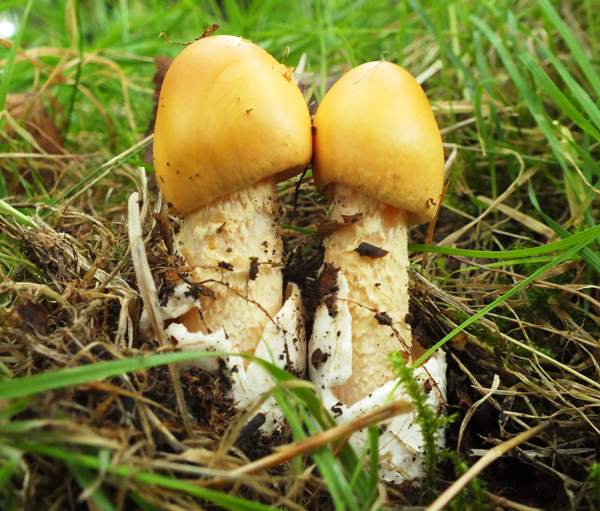
This lovely mushroom is distinguished by a thick, white
volva, faint zig-zag white-and-orange stem markings, and if not always then at least generally an absence of veil
remnants adhering to the cap. (In fact I have never seen a mature Amanita crocea with even the slightest fragment of the universal veil adhering to its cap, although occasionally other people have reported finding one or two large fragments adhering to the central region of a fully expanded cap during a prolonged spell of dry weather.)
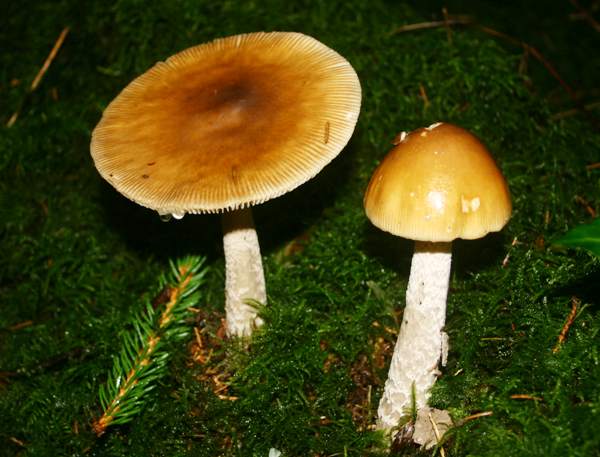
For a detailed description of the Amanita genus and identification of common species see our Simple Amanita Key...
Distribution
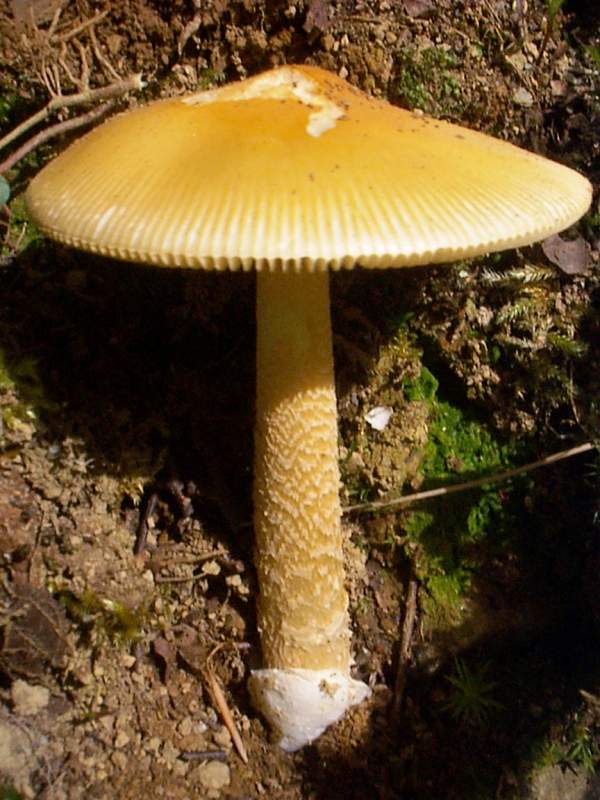
Infrequent in most parts of Britain and Ireland, Amanita crocea can, however, be locally fairly common. In my experience the Orange Grisette rarely occurs in groups of more than four or five fruitbodies at a time in Britain, but in southern Europe there are reports of large groups of the Orange Grisette appearing in mossy woodland glades.
This species is also found throughout most of mainland Europe and in many parts of North America, where it is an uncommon find and is sometimes referred to as the Saffron Ringless Amanita.
Taxonomic history
Described in 1898 by Lucien Quélet, who named it Amanita vaginata var. crocea, this lovely mushroom was given its currently-accepted scientific name in 1951 by the famous German-born mycologist Rolf Singer.
Synonyms of Amanita crocea include Amanita vaginata var. crocea Quél., and Amanitopsis crocea (Quél.) E.-J. Gilbert.
Etymology
The specific epithet refers to the saffron colouring of this mushroom. Saffron is an orange-yellow spice derived from the flowers of the Saffron Crocus, Crocus sativa. The generic name Crocus comes directly from the Latin word crocus - hence crocea.
Identification guide
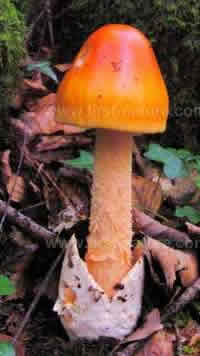 |
A note about colour
This lovely woodland mushroom varies considerably in colour. On the left is another beautiful sample with much deeper colouration than normal, and occasionally you will come across very pale specimens too. |
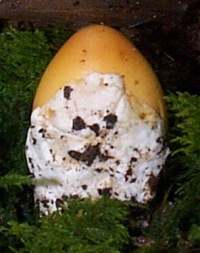 |
Cap
5 - 10cm diameter; various shades of yellow-orange with an
apricot tinge at the centre, the caps are Initially egg-shaped and smooth. |
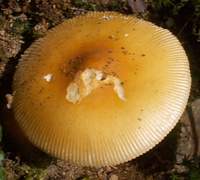 |
As the stem lengthens, pushing the cap out of the volva (the burst universal veil), the cap expands
to become convex or even flat but usually with a small raised
central area (an umbo) that is darker than the rest of the cap surface.
In very old specimens the cap sometimes turns up at
the edge, which becomes markedly striate (with comb-like radial ridges corresponding to positions of the gills below the cap). |
 |
Gills
The gills of Amanita crocea are cream, crowded, free or sometimes adnexed. There are often a few short gills, of variable length and irregularly distributed. |
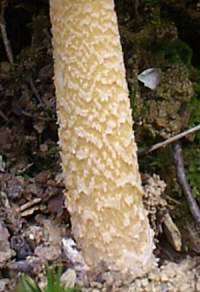 |
Stem
Stems of the Orange Grisette are 10 to 15cm long and 1 to 1.5cm in diameter, tapering (narrower at the top); pale to deep orange (closely matching the cap colour) with a white zig-zag
pattern of soft scales.
As with the other kinds of grisettes, there is no ring on the stem, but at
the base of the stipe there is a large white sack-like volva which is sometimes buried below ground level or in leaf litter |
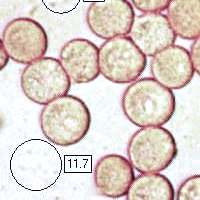 |
Spores
Subglobose, smooth, 9.5-12.5 x 8.5-11µm; inamyloid.
Spore print
White. |
Odour/taste |
Sweet-smelling and with a mildly nutty sweet
taste. |
Habitat & Ecological role |
Mycorhizal with hardwood trees, particularly
birch and beech, often in mossy woodland clearings; sometimes also found with larches, pines and spruces. |
Season |
July to October in Britain and Ireland. |
Similar species |
Caesar's Mushroom, Amanita caesarea, is rarely if ever
found in northern Europe and not yet recorded from Britain or Ireland; its cap is brilliant orange with a
striated margin, and the stipe is yellow and has a large pendent ring.
Amanita fulva has a tawny-orange cap and white gills; its
stem is smooth and featureless and it has no distinctive smell or taste |
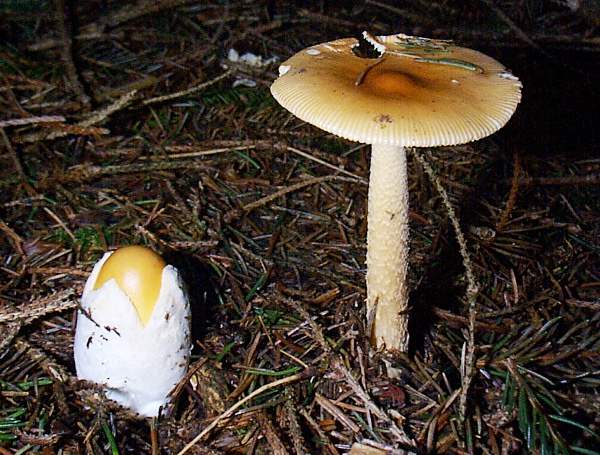
Culinary Notes
In Wild Edible Fungi: A Global Overview Of Their Use And Importance To People by E. R. Boa, Amanita crocea is listed as an edible mushroom. Some authorities state that this species is 'not known to be edible', while many field guides warn against collecting Amanita crocea because of the possibility of confusion with deadly poisonous Amanita species, and so my advice is that it should not be gathered for eating.
Reference Sources
Fascinated by Fungi, 2nd Edition, Pat O'Reilly 2016, reprinted by Coch-y-bonddu Books in 2022.
BMS List of English Names for Fungi
Geoffrey Kibby, (2012) Genus Amanita in Great Britain, self-published monograph.
Funga Nordica: 2nd edition 2012. Edited by Knudsen, H. & Vesterholt, J. ISBN 9788798396130
Paul M. Kirk, Paul F. Cannon, David W. Minter and J. A. Stalpers (2008). Dictionary of the Fungi; CABI
Taxonomic history and synonym information on these pages is drawn from many sources but in particular from the British Mycological Society's GB Checklist of Fungi.
Top of page...
Fascinated by Fungi. Back by popular demand, Pat O'Reilly's best-selling 450-page hardback book is available now. The latest second edition was republished with a sparkling new cover design in September 2022 by Coch-y-Bonddu Books. Full details and copies are available from the publisher's online bookshop...